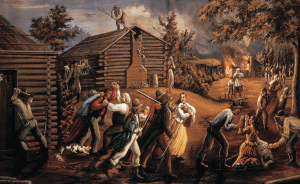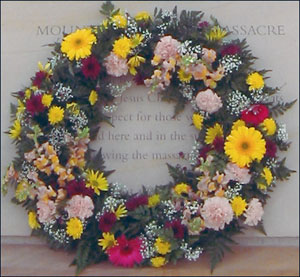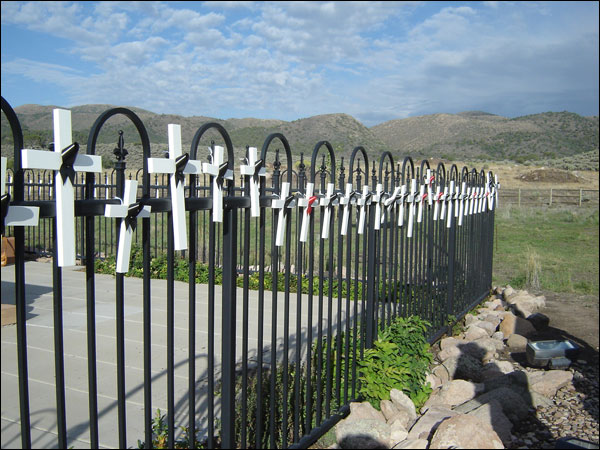 In two days, on October 30, 2013, the 175th anniversary of a very dark day in American history will pass mostly unnoticed. On this date in 1838, 18 men and boys were murdered at Haun’s Mill on the western Missouri frontier. Of the 18 victims, 17 were Mormons – mercilessly shot and killed by a group of 240 Missouri militiamen. The Haun’s Mill Massacre marked the turning point of the Mormon War, bringing about the surrender of the Prophet Joseph Smith, and that of his followers, soon after. (Readers unfamiliar with the 1838 Mormon War in Missouri can learn about it here.)
In two days, on October 30, 2013, the 175th anniversary of a very dark day in American history will pass mostly unnoticed. On this date in 1838, 18 men and boys were murdered at Haun’s Mill on the western Missouri frontier. Of the 18 victims, 17 were Mormons – mercilessly shot and killed by a group of 240 Missouri militiamen. The Haun’s Mill Massacre marked the turning point of the Mormon War, bringing about the surrender of the Prophet Joseph Smith, and that of his followers, soon after. (Readers unfamiliar with the 1838 Mormon War in Missouri can learn about it here.)
Mormons to this day remain appropriately outraged over what happened at Haun’s Mill. The people at this small settlement were attacked without provocation as they went about their daily business. And when it was over, most of the families in the little settlement of Haun’s Mill found themselves fatherless.
As horrific as this event was, the Haun’s Mill Massacre was not entirely unique in early America. As a result of 19 years of continuing expansion and settlement of the United States, by 1857 the frontier had moved about 1,000 miles to the west. It was on this frontier that another massacre occurred, culminating in yet one more very dark day in this young nation’s history. The Mountain Meadows Massacre of Utah Territory saw the murders of 120 souls who were also attacked without provocation as they went about their daily business. This time, however, it was a Mormon militia that did most of the killing. (Readers unfamiliar with the Mountain Meadows Massacre can learn more about it here.)
These two incidents of extreme and senseless bloodshed were well separated by both time and distance, yet were eerily similar in many ways. Consider the following.
The historical context for both massacres included provocative preaching by Mormon leaders.
In the case of Haun’s Mill, three months before the attack, while Mormon and non-Mormon settlers were at peace, Mormon leader Sidney Rigdon preached, “…that mob that comes on us to disturb us, it shall be between us and them a war of extermination; for we will follow them until the last drop of their blood is spilled; or else they will have to exterminate us, for we will carry the seat of war to their own houses and their own families, and one party or the other shall be utterly destroyed” (A Comprehensive History of the Church 1:441). This aggressive sermon fanned flames of suspicion and unease in the Missourians toward the Mormons.
A few weeks before the Mountain Meadows Massacre, Mormon prophet Brigham Young preached, “I am at the defiance of all hell [and] Governments, but especially ours….[they] raise a force to come and slay all the Latterdaysaints, men, women and children…they shall not come to this territory. I will fight them and I will fight all hell….I shall lay my dwelling house in ashes, I shall lay my mills in ashes…Can you flee to the mountains, men, women and children, and lay wast[e] and desolate everything before them?” (Unpublished sermon quoted in Will Bagley, Blood of the Prophets, 89-90). This alarming sermon fanned flames of suspicion and unease in the Mormon communities toward any outsiders entering Utah Territory.
Both massacres were set in motion by rumors of impending doom.
In Missouri, the non-Mormon residents of Livingston heard (falsely) from Mormon dissenters that the Latter-day Saints at Haun’s Mill were planning to attack the settlers in Livingstone County.
In Utah Territory, Brigham Young (falsely) told the Mormons that the approaching US troops were planning to hang Mormon leaders, disperse or kill all the Latter-day Saints, and “break up the Mormon kingdom.”
In each massacre, the militias acted without orders.
At Haun’s Mill, Missouri militia Colonel Thomas Jennings led the attack on the settlement; he acted on his own initiative without authority or orders from his superiors.
Mormon militia Colonel William Dame gave the order to attack and murder the emigrants at Mountain Meadows; he acted without authority, without definitive orders from his superiors.
Both massacres included strong elements of betrayal and deceit.
In Missouri, the people at Haun’s Mill and the Livingston militia had signed a peace treaty pledging an end to hostilities between them. But the Livingston militia attacked anyway.
At Mountain Meadows, the emigrants were promised that the Mormons would protect them from harm; but instead, the Mormons attacked the emigrants.
The aggressors in both massacres prepared for the attack by altering their appearances.
At Haun’s Mill, the militia “blackened their faces and attached red cloths to their hats” to distinguish themselves from the Mormons.
At Mountain Meadows, some of the Mormons disguised themselves as Indians, using war paint on their faces to deceive the emigrants.
Initially, both groups of victims were not alarmed as their attackers approached.
At Haun’s Mill, due to the peace treaty in place, the settlers viewed the arriving militia with cautious interest, not with fear.
At Mountain Meadows, though wary, the emigrants were actually thankful for their Mormon “rescuers.”
Both groups of victims were caught by surprise when attacked.
 In Missouri, the militia approached the settlement, stopped some distance away, and formed into three companies. The captain fired his gun into the air and all was silent for ten seconds as the Mormons waited and tried to determine what was going on. After this “solemn pause,” the troops raised their guns and commenced firing as the people ran for their lives.
In Missouri, the militia approached the settlement, stopped some distance away, and formed into three companies. The captain fired his gun into the air and all was silent for ten seconds as the Mormons waited and tried to determine what was going on. After this “solemn pause,” the troops raised their guns and commenced firing as the people ran for their lives.
At Mountain Meadows, unarmed emigrants walked in a single file line to what they supposed was safety: first, wagons filled with children and the wounded; next, the women; and finally, the men at the rear. Each man walked beside an armed Mormon escort. A Mormon major stopped and fired a shot into the air. When he ordered, “Halt! Do your duty!” the Mormons turned on the emigrants and began shooting as the people scattered and ran for their lives.
In both massacres, the victims sought to defend themselves, though that defense came at different points in each attack.
When the shooting began at Haun’s Mill, the Mormon men immediately ran to their pre-determined stronghold from which to defend the settlement – the blacksmith shop. Once inside the building, the Mormons pointed their guns through the cracks between the logs and returned fire.
Four days before the massacre at Mountain Meadows, the emigrant camp came under attack in what the emigrants thought was an Indian assault. They circled their wagons and returned fire with a counterattack that lasted several days before finally surrendering their weapons to the Mormons that they believed were there to rescue them.
The fatalities in each massacre were made up of captive victims.
The blacksmith shop at Haun’s Mill that was supposed to provide cover for the Mormon defenders actually became a deathtrap when the Missouri militia advanced enough to put their own guns through the cracks between the logs and fire at the men inside. The shooting was so intense that the Mormons were unable to return fire or flee.
At Mountain Meadows, the Mormon militia that promised to provide rescue for the emigrants actually became the emigrants’ executioner. Because the emigrants were required to surrender their weapons to their supposed deliverers, they were defenseless and vulnerable when they were betrayed.
In both massacres children begged for their lives – and were ignored.
At Haun’s Mill, after the shooting ceased a 10-year-old boy was discovered hiding beneath the bellows in the blacksmith shop. He begged for his life, but his pleas were ignored.
At Mountain Meadows, children reportedly clung to the legs of their attackers, begging for their lives and, in exchange, offering themselves as slaves. But their pleas were ignored.
Both massacres saw children viciously slain.
At Haun’s Mill, young Sardis Smith was brutally murdered. A Missouri militiaman held a gun to Sardis’ head and fired. To justify his brutality, the Missourian reportedly said, “Nits will make lice, and if he had lived he would have become a Mormon.” Thankfully, Sardis was the only child that died at Haun’s Mill.
At Mountain Meadows, 18 children remained alive after the attack. One was a girl of about 11-years-old. Believing she was too old to be left alive, her murderers executed her in front of the other surviving 17 children in order to ensure that the children would keep quiet about all they had seen. Another (approximately) 50 children died during the Mountain Meadows Massacre.
Extreme brutality was exhibited in both massacres.
Thomas McBride was a 62-year-old Mormon who managed to escape and run from the blacksmith shop at Haun’s Mill. When he was wounded and overtaken by militiamen, he surrendered. A Missourian took McBride’s gun and killed him with it. Then the attacker used a corn knife to hack and disfigure McBride’s body.
John Higbee ordered the killing of the women and children at Mountain Meadows. Some had their throats cut “from ear to ear” and “their heads severed from their bodies.” Others were “hacked to death with tomahawks” while Samuel Knight used the butt end of his gun to crush the skull of a 14-year-old boy.
Though pandemonium reigned throughout each massacre, neither attacking militia employed indiscriminate slaughter; their killing was selective.
The Missouri militia at Haun’s Mill killed 17 men and 1 boy, purposefully leaving the women and other children alive.
The Mormon militia at Mountain Meadows killed everyone over the age of 7 years (approximately 120 people: 40 men, 30 women, and 50 children), purposefully leaving the 17 younger children alive.
Following both massacres, the aggressors robbed their victims.
In Missouri, some of the militia looted the deserted homes at Haun’s Mill and stripped the victims’ bodies of valuables.
In Utah Territory, the militia looted the scene, taking the livestock, wagons and money that the emigrants carried with them. They also stripped the victims’ bodies of clothing and valuables.
The bodies from both massacres were hastily covered in mass graves.
 At Haun’s Mill, the surviving Mormons returned to the settlement the next day and quickly gathered their dead, threw them in a well, and covered them lightly with straw. The grieving families were never able to retrieve the bodies to give them proper burials.
At Haun’s Mill, the surviving Mormons returned to the settlement the next day and quickly gathered their dead, threw them in a well, and covered them lightly with straw. The grieving families were never able to retrieve the bodies to give them proper burials.
At Mountain Meadows there were no survivors to bury the dead. Instead, those responsible for the deaths tossed the bodies into a ravine and covered them lightly with dirt. The remains were soon uncovered and ravaged by wolves then, 20 months later, reburied in new mass graves by U.S. soldiers.
In both cases, those responsible for the murders were never brought to justice.
The members of the Missouri militia that attacked Haun’s Mill were never investigated regarding the massacre, and no court of inquiry was ever held.
Of the dozens of Mormons responsible for the Mountain Meadows Massacre, none were ever convicted and punished for the crime but one — and this not until 20 years after the killings.
Two massacres. Two heinous and horrific crimes. Two heartbreakingly senseless tragedies perpetrated by men who believed what they were doing was right. The Prophet Jeremiah spoke God’s truth when he said the hearts of men are deceitful and desperately wicked (Jeremiah 17:9). The Haun’s Mill and Mountain Meadows Massacres were manifestations of the deceit and wickedness that inhabits every heart, including our own (Romans 3:10-12).
What, then? As we cry out with the apostle Paul, “Wretched man that I am! Who will deliver me from this body of death?” we can rest in the answer: “Thanks be to God through Jesus Christ our Lord!” There is therefore now no condemnation for those who are in Christ Jesus — He sets His people free from the law of sin and death. And even more, He takes our sinful, wicked hearts and gives us new hearts with which to love, honor, and praise Him forever. Yes, thanks be to God for His merciful gift of new life, for His amazing grace in bestowing His riches on all – even the worst of sinners – yes, on all who call on Him.
(Bible references for the last paragraph above: Romans 7:24-8:2; Ezekiel 36:26-27; 2 Corinthians 5:17; John 10:10; Romans 10:12)
—
[The idea for this blog post came from our Mormon Coffee friend, spartacus. I thank him for his valuable help and encouragement. While I consulted many sources for this article, most of the information on the Haun’s Mill Massacre is from Stephen C. LeSueur, The 1838 Mormon War in Missouri, 163-168, 216; and most of the information on the Mountain Meadows Massacre is from Will Bagley, Blood of the Prophets, 4, 15, 132, 149-158, 171ff, 226, 315.]

Tough to read this article. Its hard to imagine how brutal we humans can be.
I like, though, how this article plainly criticizes both sides of the “war”. Pride, what I think ultimately leads to violence of this sort, is a result of the human condition as brought into the world by Adam. Christians are no less subject to it than are non-Christians. Mormons are no less subject to it than everyone else, too.
The fact of the matter is that we are all broken. We all fall and stumble. Fortunately, most of us do not massacre peoples, but we all sin. And sin is what separates us from God and why we need a Savior. The beauteous thing about this savior is that all we have to do is accept Him and believe upon Him to be reconciled with God. It changes one from the inside out such that our pride and other sins will diminish. We are new creatures indeed.
There is, however, some real benefits to be gained from being able to claim victim-hood and persecution status.
I’ve learned that history has to be viewed in “context”. What that means is getting some feel for what the “spirit of the times” were when events took place. Check out the 19th century especially on the frontier.
There was “Bloody Kansas”, “the Nate Turner Rebellion”, John Brown and the attack on the Harper’s Ferry arsenal and that’s just off the top of my head. Frontier justice with lynchings and wars between cattle barons and “nesters” with their barbwire ending the open range. The Montana vigilantes lynched something like six men in one day including the Virginia City sheriff.
The brutality of human beings continues today through out the world.
That’s why there is a need to know who the Lord Jesus Christ is, what He has done for us and how we can change our behavior as we claim Him as Savior and Lord.
Why am I not surprised that quite possibly the lowest point in Mormon history happened during
Brigham Young’s watch ?